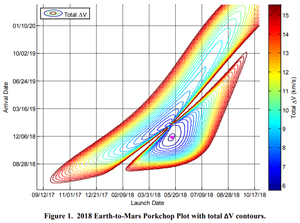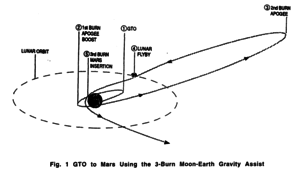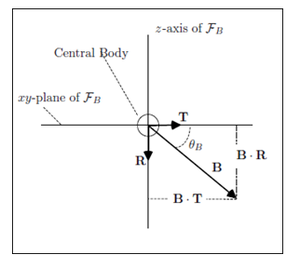Difference between revisions of "Earth-Mars Transfer Trajectory"
| (2 intermediate revisions by the same user not shown) | |||
| Line 1: | Line 1: | ||
| + | [[Category:Orbital Mechanics]] | ||
[[Image: InSight Trajectory.jpg|thumb|right|px|Earth-Mars transfer trajectory of NASA's InSight lander, including planned trajectory correction maneuvers (TCMs)]] | [[Image: InSight Trajectory.jpg|thumb|right|px|Earth-Mars transfer trajectory of NASA's InSight lander, including planned trajectory correction maneuvers (TCMs)]] | ||
| Line 49: | Line 50: | ||
I'm not sure what is used for targeting the initial transfer orbit insertion burn, but the trajectory correction maneuver burns target a point on the "B-plane" of Mars. The B-plane is defined in a JPL glossary as the "plane perpendicular to the asymptote of the incoming hyperbolic trajectory of the object relative to the Earth."<ref>https://cneos.jpl.nasa.gov/glossary/b_plane.html</ref> I think of it as the "bullseye" plane, which is the plane of the dartboard from the perspective of the person throwing darts. B-plane targeting was originally developed for gravity-assist maneuvers, but it has come to be used for missions where the destination is the planet itself as well. | I'm not sure what is used for targeting the initial transfer orbit insertion burn, but the trajectory correction maneuver burns target a point on the "B-plane" of Mars. The B-plane is defined in a JPL glossary as the "plane perpendicular to the asymptote of the incoming hyperbolic trajectory of the object relative to the Earth."<ref>https://cneos.jpl.nasa.gov/glossary/b_plane.html</ref> I think of it as the "bullseye" plane, which is the plane of the dartboard from the perspective of the person throwing darts. B-plane targeting was originally developed for gravity-assist maneuvers, but it has come to be used for missions where the destination is the planet itself as well. | ||
| − | == Aerocapture and hypersonic entry == | + | ==Aerocapture and hypersonic entry== |
| − | Using the concepts of Aerocapture and hypersonic entry a vehicle can arrive at Mars with a high residual velocity, and use friction with the planetary atmosphere to slow down and eventually land. This allows for much shorter travel times with | + | Using the concepts of Aerocapture and hypersonic entry a vehicle can arrive at Mars with a high residual velocity, and use friction with the planetary atmosphere to slow down and eventually land. This allows for much shorter travel times with about the same fuel use as more conventional transfer orbits. An average Hohmann transfer orbit to Mars requires 259 days and a delta-v of 3,9 km/s. An hyperbolic orbit depending on aerocapture for braking can reduce this to 90-150 days depending on the year of travel. For example in aug. 2020 for a delta-V of 4,8 km/s Mars could be reached in 96 days according to the [https://trajbrowser.arc.nasa.gov/traj_browser.php Trajectory Browser] . |
==topics to elaborate on== | ==topics to elaborate on== | ||
Latest revision as of 06:49, 27 August 2021
An Earth-Mars transfer trajectory is an orbital path which a spacecraft follows to travel between Earth and Mars. Several types of trajectories have been studied, but all will satisfy the following conditions:
- The starting point must be near the Earth in its orbit around the sun
- The ending point must intersect Mars in its orbit around the sun
- The intervening trajectory must be heliocentric, though one or more gravitational swing-bys of other bodies are allowed
Not all Mars transfer orbits are Hohmann transfers. This is due to the difference in the plane of Earth and Mars's orbit, and can also be due to constraints on launch windows. There are many variations on this theme, such as whether the spacecraft ends in a Mars-centered orbit or if the spacecraft directly enters the atmosphere from the heliocentric transfer orbit. Other less common variations include the starting orbit at Earth, which could be a low Earth orbit or could instead the mission could begin from geostationary transfer orbit (GTO) as in the MEGA proposals of the late 90's, or one could vary the heliocentric portion of the flight to include a low-thrust trajectory.
The NASA Ames research center offers a practical Trajectory Browser application than can calculate Mars transfer orbits.

Contents
Launch Period
A launch period is a span of days during which a launch vehicle can place the spacecraft in the desired Earth-Mars transfer orbit. A launch period is different from a launch window which is a specific time that a launch can take place on a particular day in the launch period. There are many launch windows in a launch period. Sometimes the phrase launch opportunity is used to refer to the specific year in which a launch period takes place.
Launch periods are generally constrained by the power of the launch vehicle whereas launch windows are also constrained by launch geometry. One way to visualize an acceptable launch period for various values of delta-v is a porkchop plot, which plots contours of constant delta-V on top of launch dates and landing dates. Pick a value of delta-V, and then use that contour to determine the launch period by observing the earliest launch date and latest launch date.
The gap in the porkchop plot is caused by non-planar delta-v in the transfer burns. Since the Earth and Mars orbit in slightly different planes, the most expensive time to launch is when the earth and Mars are at points where their planes are separated by the maximum amount. Conversely, the cheapest time to launch is when their planes intersect.
One drawback of porkchop plots is that they are only for single-arc transfers, which is why they have such large gaps as a result of launch and arrival plane changes. A different transfer trajectory could be constructed which uses a mid-course plane change maneuver at the intersection of the Earth and Mars orbital planes. However, most launch vehicles would not offer this capability.
There are other real-world considerations which affect the launch period; the ability of MRO to be at the right place at the right time to serve as a relay satellite during entry, descent, and landing constrained the end of Insight's launch period.
Leaving Earth
Typically a mission will first launch into a relatively low Earth-centered parking orbit, then it will coast in that orbit for a variable amount of time, and finally the second or third stage of the launch vehicle will inject the spacecraft into a Mars transfer orbit. This injection can either take place all at once, as with the 8 minute burn for Curiosity's launch, or it can take place over several orbits with gradual apogee-raising maneuvers as in the case of Mars Orbiter Mission.
The parking orbit can be of any inclination. A heavy spacecraft like Curiosity may need to launch into a lower inclination parking orbit so it can take more advantage of the Earth's rotation at launch, however a small spacecraft like Insight might not. Insight launched south from Vandenberg into a polar orbit, coasted for 3/4 of a parking orbit, and the second stage reignited its engines approximately over Alaska to place Insight on the Mars transfer orbit.
At the completion of this Mars transfer insertion burn, the spacecraft will not be exactly on its final course. The spacecraft will be set on a course which intentionally misses Mars so that the non-sterilized launch vehicle does not accidentally hit and contaminate the surface of Mars. After the Mars-transfer orbit burn is completed, the spacecraft will separate from the launch vehicle. The spacecraft will eventually perform a trajectory correction maneuver which will set it on the correct course, but the expended rocket parts will remain on their initial trajectory and miss Mars.
There are other ways of leaving Earth. One such way is the Moon and Earth Gravity Assist (MEGA) scheme, which has never been performed. In this scheme, a small (~200 kg) spacecraft hitches a ride as a secondary payload on a launch to geostationary transfer orbit (GTO). Once in GTO, the spacecraft will perform a burn at perigee which will raise its apogee enough to take it out beyond the Moon, but not quite escape Earth's gravitational pull. At this far apogee the spacecraft might perform a small burn to target a lunar gravity assist as it comes back towards the Earth. Finally, at the next perigee, the spacecraft will perform its Mars transfer orbit insertion burn.[2]
Another way to escape Earth would be a low-thrust trajectory, where the spacecraft slowly spirals out away from Earth until its eventual escape into heliocentric orbit.
Regardless of the escape scheme, practical considerations impose constraints on the trajectory and timing of maneuvers. For instance, a mission might need to time things so that spacecraft separation occurs in view of a deep space tracking station such as Goldstone.
Targeting Mars
I'm not sure what is used for targeting the initial transfer orbit insertion burn, but the trajectory correction maneuver burns target a point on the "B-plane" of Mars. The B-plane is defined in a JPL glossary as the "plane perpendicular to the asymptote of the incoming hyperbolic trajectory of the object relative to the Earth."[3] I think of it as the "bullseye" plane, which is the plane of the dartboard from the perspective of the person throwing darts. B-plane targeting was originally developed for gravity-assist maneuvers, but it has come to be used for missions where the destination is the planet itself as well.
Aerocapture and hypersonic entry
Using the concepts of Aerocapture and hypersonic entry a vehicle can arrive at Mars with a high residual velocity, and use friction with the planetary atmosphere to slow down and eventually land. This allows for much shorter travel times with about the same fuel use as more conventional transfer orbits. An average Hohmann transfer orbit to Mars requires 259 days and a delta-v of 3,9 km/s. An hyperbolic orbit depending on aerocapture for braking can reduce this to 90-150 days depending on the year of travel. For example in aug. 2020 for a delta-V of 4,8 km/s Mars could be reached in 96 days according to the Trajectory Browser .
topics to elaborate on
- opposition vs conjunction class transfers
- plane changes
- low-thrust trajectories
- earth orbit part, launch sites, equatorial vs polar parking orbits (or lack of difference between them)
- GTO to Mars transfer scheme
- mars capture schemes: aerobraking, ballistic capture
References
- https://blog.adafruit.com/2018/07/26/how-porkchop-plots-determine-earth-to-mars-trajectories-nasa/
- https://trs.jpl.nasa.gov/bitstream/handle/2014/44336/13-0679_A1b.pdf?sequence=1 Ryan C. Woolley and Charles W. Whetsel "On the nature of Earth-Mars porkchop plots" 2014 AAS
- ↑ https://trs.jpl.nasa.gov/bitstream/handle/2014/44336/13-0679_A1b.pdf?sequence=1
- ↑ Paul Penzo, "Mission design for Mars mission using the Ariane ASAP launch capability," 1999. https://trs.jpl.nasa.gov/bitstream/handle/2014/16879/99-0288.pdf?sequence=1
- ↑ https://cneos.jpl.nasa.gov/glossary/b_plane.html









